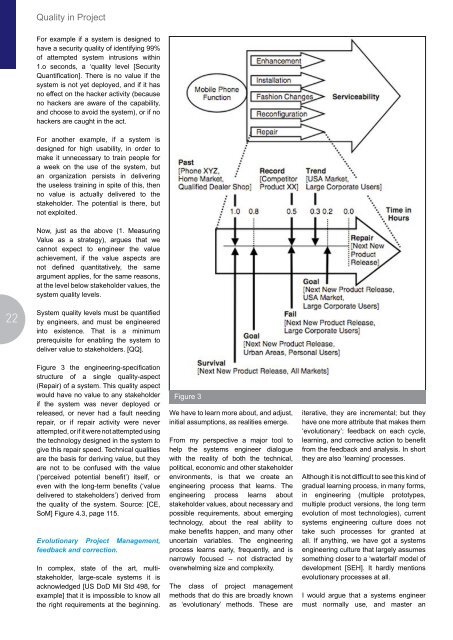Comparison of Change Management Systems
Comparison of Change Management Systems
Comparison of Change Management Systems
You also want an ePaper? Increase the reach of your titles
YUMPU automatically turns print PDFs into web optimized ePapers that Google loves.
22<br />
Quality in Project<br />
For example if a system is designed to<br />
have a security quality <strong>of</strong> identifying 99%<br />
<strong>of</strong> attempted system intrusions within<br />
1.o seconds, a ‘quality level [Security<br />
Quantification]. There is no value if the<br />
system is not yet deployed, and if it has<br />
no effect on the hacker activity (because<br />
no hackers are aware <strong>of</strong> the capability,<br />
and choose to avoid the system), or if no<br />
hackers are caught in the act.<br />
For another example, if a system is<br />
designed for high usability, in order to<br />
make it unnecessary to train people for<br />
a week on the use <strong>of</strong> the system, but<br />
an organization persists in delivering<br />
the useless training in spite <strong>of</strong> this, then<br />
no value is actually delivered to the<br />
stakeholder. The potential is there, but<br />
not exploited.<br />
Now, just as the above (1. Measuring<br />
Value as a strategy), argues that we<br />
cannot expect to engineer the value<br />
achievement, if the value aspects are<br />
not defined quantitatively, the same<br />
argument applies, for the same reasons,<br />
at the level below stakeholder values, the<br />
system quality levels.<br />
System quality levels must be quantified<br />
by engineers, and must be engineered<br />
into existence. That is a minimum<br />
prerequisite for enabling the system to<br />
deliver value to stakeholders. [QQ].<br />
Figure 3 the engineering-specification<br />
structure <strong>of</strong> a single quality-aspect<br />
(Repair) <strong>of</strong> a system. This quality aspect<br />
would have no value to any stakeholder<br />
if the system was never deployed or<br />
released, or never had a fault needing<br />
repair, or if repair activity were never<br />
attempted, or if it were not attempted using<br />
the technology designed in the system to<br />
give this repair speed. Technical qualities<br />
are the basis for deriving value, but they<br />
are not to be confused with the value<br />
(‘perceived potential benefit’) itself, or<br />
even with the long-term benefits (‘value<br />
delivered to stakeholders’) derived from<br />
the quality <strong>of</strong> the system. Source: [CE,<br />
SoM] Figure 4.3, page 115.<br />
Evolutionary Project <strong>Management</strong>,<br />
feedback and correction.<br />
In complex, state <strong>of</strong> the art, multistakeholder,<br />
large-scale systems it is<br />
acknowledged [US DoD Mil Std 498, for<br />
example] that it is impossible to know all<br />
the right requirements at the beginning.<br />
Figure 3<br />
We have to learn more about, and adjust,<br />
initial assumptions, as realities emerge.<br />
From my perspective a major tool to<br />
help the systems engineer dialogue<br />
with the reality <strong>of</strong> both the technical,<br />
political, economic and other stakeholder<br />
environments, is that we create an<br />
engineering process that learns. The<br />
engineering process learns about<br />
stakeholder values, about necessary and<br />
possible requirements, about emerging<br />
technology, about the real ability to<br />
make benefits happen, and many other<br />
uncertain variables. The engineering<br />
process learns early, frequently, and is<br />
narrowly focused – not distracted by<br />
overwhelming size and complexity.<br />
The class <strong>of</strong> project management<br />
methods that do this are broadly known<br />
as ‘evolutionary’ methods. These are<br />
iterative, they are incremental; but they<br />
have one more attribute that makes them<br />
‘evolutionary’: feedback on each cycle,<br />
learning, and corrective action to benefit<br />
from the feedback and analysis. In short<br />
they are also ‘learning’ processes.<br />
Although it is not difficult to see this kind <strong>of</strong><br />
gradual learning process, in many forms,<br />
in engineering (multiple prototypes,<br />
multiple product versions, the long term<br />
evolution <strong>of</strong> most technologies), current<br />
systems engineering culture does not<br />
take such processes for granted at<br />
all. If anything, we have got a systems<br />
engineering culture that largely assumes<br />
something closer to a ‘waterfall’ model <strong>of</strong><br />
development [SEH]. It hardly mentions<br />
evolutionary processes at all.<br />
I would argue that a systems engineer<br />
must normally use, and master an



